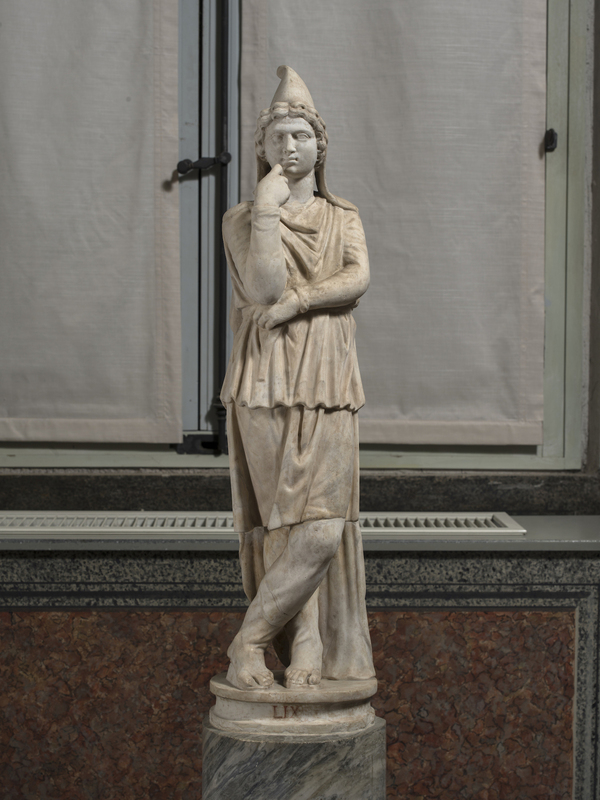Statuette of Attis
This statuette depicts Attis, a young Phrygian shepherd loved by the goddess Cybele in a story told by Ovid. The figure is standing on its right leg, with the left crossed in front of it. It is wearing Oriental-style clothing: a Phrygian cap and loose pants, or anaxirides. This sculpture, mentioned in Room 8 of the Palazzina Borghese in 1650 and described as ‘a Phrygian shepherd’, may be dated to the second century CE.
Object details
Inventory
Location
Date
Classification
Medium
Dimensions
Provenance
Borghese Collection, cited in 1650 by Manilli in room 8 (p. 87); Inventario Fidecommissario Borghese 1833, C., p. 45, no. 52. Purchased by the Italian State, 1902.
Conservation and Diagnostic
- 1996-97 - Liana Persichelli
Commentary
In the woods, a Phrygian boy, Attis, of handsome face, won the tower-bearing goddess with his chaste passion. She desired him to serve her, and protect her temple, and said: ‘Wish, you might be a boy for ever’. He promised to be true, and said: ‘If I’m lying, may the love I fail in be my last love’.
Ovid, Fasti IV, 223–228
In 1650, Manilli mentioned the statuette of a ‘Phrygian shepherd three palms in height set atop a black stone pillar ten palms tall’ in the Saturn Room, today’s Room 8, the counterpart of a small statue of Hercules placed on a similar column (p. 87). It was later recalled by Montelatici in 1700 in the same location, which the author called the Silenus Room, the first in the North apartment. This scholar described the statuette as a ‘Shepherd, possibly Paris, wearing a Phrygian costume with his face supported by his elbow’ (p. 208). In 1841, Nibby listed it among the statues present in Hall 1 as ‘Statuette of Paris’ (p. 914). Calza described it as ‘Wearing the usual barbarian attire, with a Phrygian cap on its head’ (1957, p. 12, no. 102). It was mentioned in its present placement in Room 7 in the catalogue of the archaeological collection compiled by Moreno in 2003 (p. 244, no. 234).
This sculpture is a small rendition of a young man identified as Attis, a Phrygian god worshiped alongside the great mother of the gods, Cybele. The figure is standing, its left arm bent horizontally to support the right elbow. The left leg is crossed over the right, which is bearing the body’s weight. The young man is wearing a sleeved tunic that comes down to his knees and a long cloak covering his shoulders and reaching down to the ground. His legs are clad in anaxirides, the typical loose oriental trousers. On the head is a Phrygian cap, which is conical with two flaps that come down to the shoulders. Under the cap, we can make out a head of short curls that frame the face and cover the ears. The features are those of a young person: full cheeks, lips slightly parted in the hint of a smile.
In his Fasti, Ovid tells of how Cybele was overcome by a chaste love for this young man who was her paredros and asked him to be forever puer, pure, and to be her priest. He fervently swore to do so. However, the young man became enamoured with the nymph Sagaritis, and Cybele, filled with rage and seeking revenge, wounded the tree, thus killing the nymph who lived within. Attis, made mad by guilt, punished himself by denying his own virility and, overcome by furor, he evirated himself with a sharp rock (Ovid, Fasti IV, 223–244).
Kalveram identified the Borghese sculpture with Paris and attributed the head, the right forearm, part of the left forearm, most of the legs, the lower part of the tunic covering the back and the cap to conservation (1995, p. 219, no. 108).
The iconographic type may be compared to a small statue of Attis captured in the same stance and similarly attired found in the atrium of building VI 14, 37 (also known as ‘officina lignaria’) in Pompeii and preserved in the National Archaeological Museum in Naples (inv. 120425: Ward-Perkins, Claridge 1976, no. 127).
This work may be dated to the second century CE.
Giulia Ciccarello
Bibliography
- I. Manilli, Villa Borghese fuori di Porta Pinciana, Roma 1650, p. 87.
- D. Montelatici, Villa Borghese fuori di Porta Pinciana con l’ornamenti che si osservano nel di lei Palazzo, Roma 1700, p. 208.
- Indicazione delle opere antiche di scultura esistenti nel primo piano della Villa Borghese, Roma 1840, p. 11, n. 18.
- A. Nibby, Roma nell’anno 1838, Roma 1841, p. 914, n. 18.
- Indicazione delle opere antiche di scultura esistenti nel primo piano della Villa Borghese”, Roma 1854 (1873), p. 13, n. 17.
- A. Venturi, Il Museo e la Galleria Borghese, Roma 1893, p. 20.
- G. Giusti, The Borghese Gallery and the Villa Umberto I in Rome, Città di Castello, p. 31.
- P. Della Pergola, La Galleria Borghese in Roma, (3° Edizione), Roma 1954, p. 22.
- R. Calza, Catalogo del Gabinetto fotografico Nazionale, Galleria Borghese, Collezione degli oggetti antichi, Roma 1957, p. 12, n. 102.
- J.B. Ward-Perkins, A. Claridge, Pompeii AD 79. Catalogue of exhibition held at the Royal Academy of Arts, London 1976.
- P. Moreno, Museo e Galleria Borghese, La collezione archeologica, Roma 1980, p. 20.
- P. Moreno, S. Staccioli, Le collezioni della Galleria Borghese, Milano 1981, p. 101, fig. a p. 88.
- K. Kalveram, Die Antikensammlung des Kardinals Scipione Borghese, in “Römische Studien der Bibliotheca Hertziana”, 11, Worm am Rehin, 1995, p. 219, n. 108.
- P. Moreno, C. Stefani, Galleria Borghese, Milano 2000, p. 181, n. 14.
- P. Moreno, A. Viacava, I marmi antichi della Galleria Borghese. La collezione archeologica di Camillo e Francesco Borghese, Roma 2003, p. 244, n. 234.
- Schede di catalogo 12/99000415, G. Ciccarello 2020.


